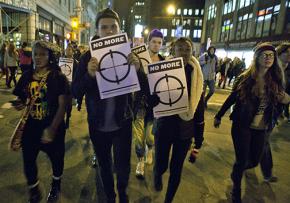Big Apple for Mike Brown
describes the powerful experience marching all across Manhattan into the early morning hours to protest the travesty of justice in Ferguson.
IN NEW York City, we've had daily demonstrations since the decision was announced to not indict Darren Wilson in the murder of unarmed Black teenager Mike Brown in Ferguson, Missouri. Last Tuesday evening, I, along with over a thousand people, marched and chanted for five hours from Union Square on 14th Street to 125th Street in Harlem.
The march was multi-cultural, mostly young and led by people of color who served as march marshals and leaders of impromptu open mics. I'm not sure what organization was behind it, but some of the marshals were wearing headsets, and they were able to effectively close the gaps, control traffic and keep us together. The police played no role.
It began with a rally at Union Square where conversations with people ranged from the unjust verdict and killer cops to the role of Black celebrities in struggle to the portrayal of Black characters on the Shonda Rhimes television shows Scandal and Grey's Anatomy. All issues of race were on the table.
We marched from Union Square to the West Village, where various LGBT bar patrons came out to show their solidarity. We then marched as far south as Houston Street, where we looped back and made it to 14th Street and 5th Avenue and then north to Bryant Park.

We marched straight through the heart of Time Square, where we held the longest sustained chant I've ever been a part of. We chanted "Hands Up. Don't shoot," all of us with our hands raised. The sea of people was visibly and audibly profound at that moment as we witnessed people sticking their hands up, inside and outside their cars, and we saw the eyes of tourists reading our lips.
People honked to our rhythm, and a few cried silently in their cars. Tears of joy. Tears of relief. People were doing something about the injustice. Of course, there were angry honkers, but most chose not to express their frustration with our civil disobedience that way. Some just ate a sandwich...others lit a cigarette.
We made our way to Riverside Drive around 72nd Street when suddenly marchers decided this was the opportunity to take the highway. Some people decided they wouldn't and went home. However, the vast majority of marchers crossed Riverside Park, went over the highway wall and began marching on both directions of the highway.
You could hear: "I think we're taking the highway." "Holy shit, they're taking the highway!" "Shit, we're marching on the highway. This is crazy!" It was exhilarating both because none of us normally march and shut down highways in our free time, and because we just didn't know where this march was going or what would happen to us.
THE COMRADES I had marched with earlier seemed to have been gone by that point, but I chose to continue at my own risk. For the first time in my life, I felt okay with being arrested if it came to that.
Much of that had to do with the solidarity within the march. People, not just marshals, took up the task of keeping us together by closing any gaps in case stray groups of people got corralled, beaten up, or arrested as had happened during Occupy or even just last week in Oakland.
But on the highway, it was old and young, liberals, anarchists, and socialists. I saw women carrying Prada bags and hippie-style backpacks. It was quite the mix of people.
We made it to 125th Street (also known as Martin Luther King Boulevard) and marched down to Adam Clayton Powell Avenue. Most people dispersed, exhausted at this point.
But a good 150 or so stayed and listened to brief speakers through the people's mic. One woman guilted marchers for not caring about other Black deaths in the city. Someone responded that the roots of her assertion were no better than blaming Black on Black crime as the problem.
Another speaker urged people to continue the demonstrations day after day and to come out to Staten Island for the case of Eric Garner, who was strangled to death by the NYPD this summer. One guy asked us to sit down on the pavement as he sang a protest song about police violence.
I may still be recovering from leg pain after marching nearly the entire length of Manhattan, but it was worth it. The moment is ripe for activating people who've long resisted getting into the streets.
Friends of mine came out to the demonstration without me having to make a direct request for them to come. Others I know said they had a similar experience with their friends who came. And I'm sure that if I'd asked many more, it would have been the same response.
People feel so absolutely disgusted at the level of injustice in this country that taking to the streets felt like an absolute requirement as a human being that day. And people continue to feel that way as friends and co-workers, families and lovers, activists and the inactive discuss the importance of defending the fact that Black lives matter in this world.


